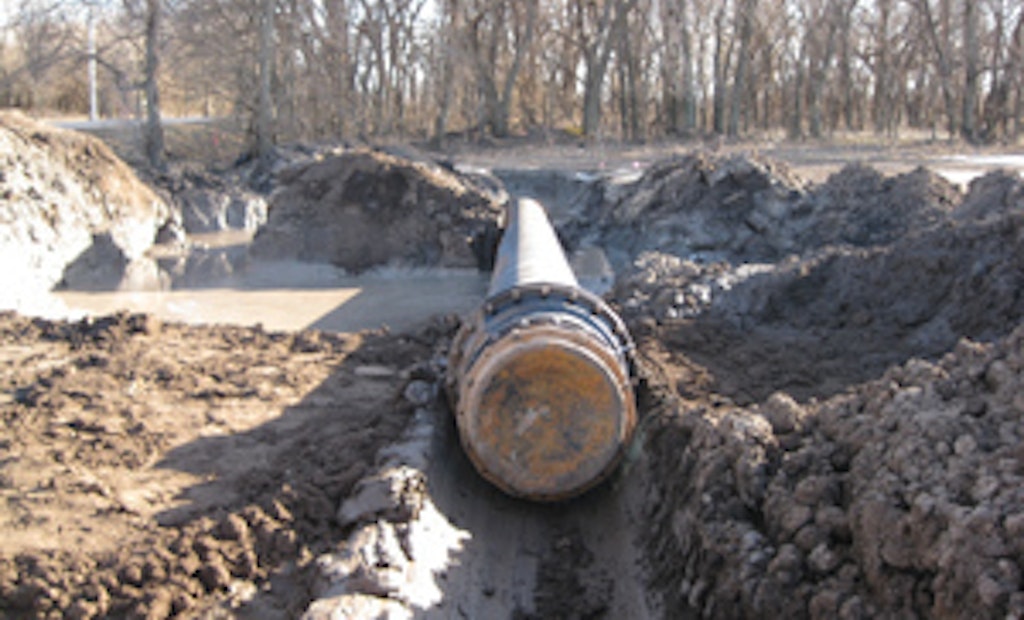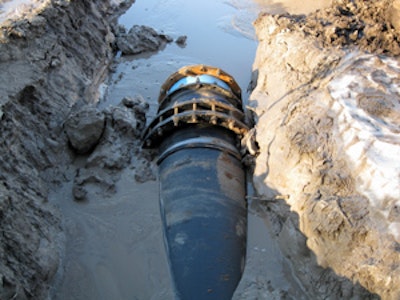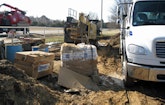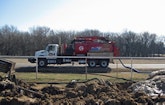
Interested in Relining/Rehab?
Get Relining/Rehab articles, news and videos right in your inbox! Sign up now.
Relining/Rehab + Get AlertsWith development expanding in the northwest section of Wichita, Kan., the city hired local contractor Wildcat Construction to open-cut and replace 10-inch water mains with 32.6-inch HDPE pipe.
The project also included extending the upgraded mains. One line would pass under Dry Creek, 160 feet wide, and through a 14-foot right-of-way with overhead power lines. Ditch work was out of the question, so project superintendent Dan Voegeli hired Horizontal Boring & Tunneling Co. in Exeter, Neb., to install 680 feet of pipe using horizontal directional drilling.
Although the length of the bore was short, the project was arduous. “So many circumstances piled together that we had to mentally prepare ourselves each morning to earn every dollar that day,” says directional drilling superintendent Craig True.
The team successfully battled severe weather, buried debris, changes of site conditions and work restrictions that, if violated, would shut down the project for two years.
Game plan
The bore path traversed a horse pasture, the creek and a wooded area, and ended in another pasture. The city surveyed and staked the right-of-way it had purchased from the horse farm owner after a four-year court battle. “Just stepping over the yellow rope would re-ignite the conflict and stop work for 24 months,” says True.
True used Atlas Bore Planner software from Vermeer Corp. to create a drill plan that minimized risk to the project. The program projects a map on a computer monitor delineating the course the drill operator should follow.
The crew used a D80x100 Series II Navigator horizontal directional drill from Vermeer Corp., with standard duckbill drill head and walkover locator, and Model 4200 mud cleaner from Triflo International. The project required HYDRAUL-EZ (AMCOL International) 200 mesh sodium bentonite with special dry polymer additives to seal the hole from water infiltration and facilitate the bore.
Wildcat workers fused and laid out the HDPE pipe along the highway right-of-way. Meanwhile, subcontractor Wolverine Hydrovac Excavation in Platt, Kan., potholed the access pit in the horse pasture with a System 4000 air-vacuum excavator from VACMASTERS that operated up to 200 feet from the truck.
The pit was 600 feet from the pasture gate, and although the 8-foot-wide drill rig could navigate tight spaces, there wasn’t enough room to turn it sideways or stand beside it to load more drill rod. Power lines prevented a boom truck on the road from lifting rod racks over the fence.
“For every 285 feet we drilled, we had to unhook and reverse the rig out of the pasture, back it onto the road, load the drill rod, track the machine back in and hook it up,” says True. The drill operator made the trip four times to complete the pilot bore.
Overcoming challenges
The soil was mostly fine sand until the locator lost signal in a dense salt seam during the descent to 31 feet. As the drill bit began to penetrate the layer, workers standing within 1,000 feet could feel the vibrations.
“Salt degrades the polymers in the bentonite mixture and freshwater infiltration dilutes it,” says True. “To compensate, we added 240 additional bags of bentonite, or 12,000 pounds.”
Work restrictions prevented the team from stringing pipe that returned drilling fluid from the exit site to the mud cleaner. Wolverine brought a Vactor HXX hydroexcavator to suck up the fluid and transport it to the cleaner, which recycled almost a million gallons.
Elliptical shaking screens in the machine separated sand and silt from the debris, then the bentonite mixture was pumped through hydrocyclones before dropping into a clean tank. A charging pump in the tank transferred the slurry to the mud pump on the drill rig parked beside the cleaner.
Heavy metal
Box springs, hot-water heaters, stoves, and other metal objects buried along the creek bank to stabilize it acted like an antenna, defusing the locator signal and causing the drill head to divert from its path.
“The locator would get occasional glimpses, which forced the drill operator to proceed foot by foot instead of rod by rod,” says True. “In situations like that, his instincts were invaluable.” The pilot bore was completed online in less than three days.
Winter arrived as the crew moved ahead with 24-, 30-, 36- and 44-inch ream passes before pulling through the HDPE pipe. With weeks of temperatures in the teens, the drilling fluid began freezing in the hole and mud cleaner. Workers ran heaters in the cleaner tanks and drained the lines on both machines nightly. “If work stopped for more than an hour, we had to drain and antifreeze all the lines again,” says True. The Vactor had its own heater.
Blizzard conditions required extra safety precautions for crews loading drill rod alongside the road. Work continued as long as the drill operator could see the rod in front of him and fluid flowed when the worker on the mud cleaner activated the charging pump. “It was cold and arduous for everyone, but once we begin drilling, we rarely stop,” says True.
The crew’s perseverance was rewarded with one of the best pullbacks in company history. “We flooded the pipe with freshwater to make it neutrally buoyant and in it went,” says True.
The project lasted two months and no one stepped over the yellow rope.










